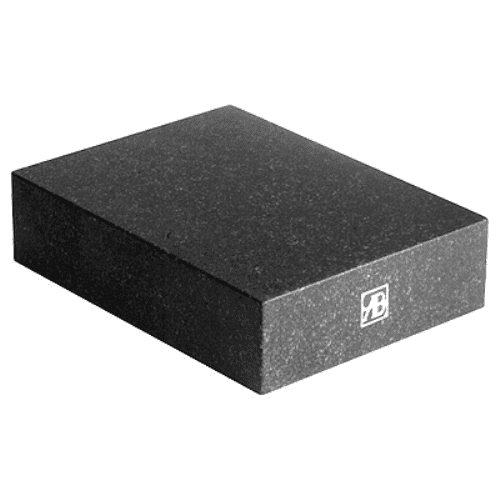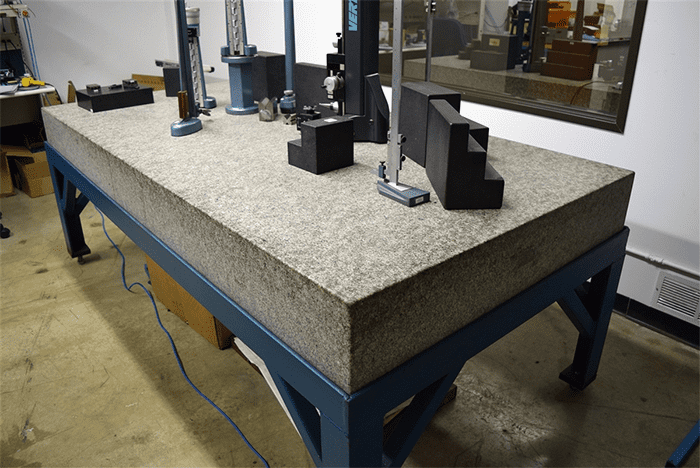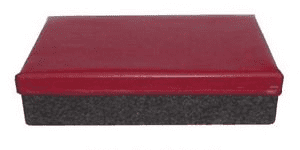
Grade A Black Granite Surface Plate, 18" x 12". About $160 on Amazon...
Surface Plates are solid flat plates used to mimic a perfect 2D plane as accurately as possible to facilitate other measurements being made on top that plane. Typical uses are precision inspection (for quality control, for example), marking out (putting precise markings to guide machine work), and tooling setup.
Many of the most common measurements are done with a Height Gauge. A Surface Plate with height gauge is an extremely handy thing for any CNC'er or machinist to have on hand, so I recommend getting the set relatively early on.
Surface Plate Material: Granite, Cast Iron, Steel, or Glass
Surface plates are usually made of granite, and they come in a variety of sizes and grades. There are cast iron, steel, and glass surface plates available, but most prefer to stick with granite.
Granite came into wide use during World War II. Before that time, most surface plates were metal. Granite surface plates were conceived as a means of saving the metal for more critical applications. The idea to use granite came about by the happy coincidence of Wallace Herman owning both a monument and a metal shop in Dayton, Ohio.
Granite has a number of advantages over cast iron. It's more durable and won't rust. These advantages are why granite surface plates stayed popular even post-World War II.
You can find both black and pink granite used to make surface plates, with black granite being more popular. Pink granite has more quartz, and therefore more wear resistance than black granite. Quartz is more than twice as resistant to wear as the other minerals in granite. However, Pink Granite isn't as strong as Black Granite and so it is normally desirable for a pink granite surface plate to be thicker. Black Granite has superior stiffness, vibration damping, and machinability.
Before granite surface plates became prevalent, Cast Iron was the most common material for surface plates. It is still popular for certain applications because it is easier to work it to a particular degree of precision than granite. In fact, cast iron surface plates may be used as a tool to help lap (resurface) a granite surface plate.
Surface Plate Grades and Precision
Surface Plate Grades determine their flatness. Standard grades include:
- AA (Most accurate): These are referred to as laboratory grade. Their flatness is (40 + diagonal (inches) of surface plate squared / 25) x 0.000001".
- A: These are Inspection Grade. They're the AA spec x 2.
- B: These are Toolroom Grade. They're AA x 4.
- Workshop Grade (Least accurate): These are not really suitable for CNC applications, so I won't quote a spec.
Try to purchase an "A" grade granite surface plate in the largest size that you can afford and that fits comfortably in your shop. This grade is intended for inspection work (quality control), and so covers the broadest range of use.
The ASME (American Society of Mechanical Engineers) has published ASME B89.3.7 - 2013 which is the current standard for granite surface plates.
All surface plates must be calibrated regularly to ensure their accuracy has not been compromised by chipping, warping, or excessive wear.
The flatness of a surface plate is defined by two parallel planes-the base plane and the roof plane. The distance between the two planes is the overall flatness.
Standard Surface Plate Sizes
Standard surface plate sizes are 18 x 24 in., 24 x 36 in., 36 x 48 in. and 48 x 72 in, but you can get most any size custom made if need be. I have an "A" Grade 24 x 36 in A Class granite surface plate for my metrology needs. It's a very nice surface plate for a small shop, but larger shops will want even larger surface plates and will likely have more than one.
Reducing Wear, Cleaning, and Extending Life of Granite Surface Plates
Reducing wear is all about keeping granite surface plates clean. Airborne abrasive dust is the greatest source of wear, and it will also tend to embed in work pieces and the contact surfaces of gages.
Cover your plate to protect it from dust and damage. Rotate it periodically so that wear isn't always in the same place. Wherever possible use carbide pads on gauging as it is much less likely to have embedded abrasive dust.
Surface Plates should also be kept as clean as possible. Swarf and other debris can easily interfere with accurate measurements. Special Surface Plate cleaner is available relatively cheaply (about $30 on Amazon for a gallon) and should be used to prevent any chemical erosion of granite surface plates.
Ideally, clean your plate at the beginning and end of the day with appropriate cleaner. Note that the evaporation of the cleaner can cause chilling, which may distort the surface. Allow an hour for small plates to normalize and 2 hours for large plates.
Depending on how porous the granite in your plate is, retaining water from cleaning can be an issue that makes precision tooling more likely to rust.
Surface Plate Calibration
Surface Plates can experience chipping, warping, and just plain wear, so they must be calibrated regularly. Often, the wear will be localized due to a particular tool, such as a height gauge, being used in the same place constantly.
Here's a fascinating video that walks through the process of testing and calibrating a surface plate in the field:
A process called lapping can be used to increase the flatness of a plate as needed.
Don't Use Your Surface Plate as a Counter!
Surface Plates are not counters. Don't set anything on the surface plate other than gages and the pieces being measured.
Say you let someone put a Coke can on a Surface Plate. That can may have dribbled so there's a little Coke on the bottom of the can. But Coke is acidic and it will eat into your Surface Plate, damaging it.
Placing random things on Surface Plates can also transfer harmful debris that upsets delicate precision and abrades the Surface Plate.
Surface Plate Accessories
There is a huge variety of accessories used with surface plates. We won't try to cover them all, just the most commonly used ones.
Ledges and Threaded Metal Inserts
Ledges are a part of the surface plate and must be specified when you order your plate. Ledges are used to facilitate work clamping.
Threaded metal inserts may be embedded in the granite to facilitate clamping. Keep the metal below the level of the granite to facilitate accuracy.
Surface Plate Stands
Proper support is essential for surface plates to minimize warping. Granite Surface Plates should be supported at 3 points, ideally located 20% of the length in from the ends of the plates. A precision surface can only be supported accurately by 3 points, not 4 or more.
A variety of stands are available to support all types of surface plates. Smaller surface plates can be placed on any bench, but larger plates benefit from proper suspension.
Here's a typical fabricated stand for the sort of large surface plates found in the inspection and quality departments of many machine shops:

Temperature Controlled Room
It doesn't do you much good to specify a laboratory grade surface plate and then keep it in a room that isn't temperature controlled. For the highest degree of accuracy and repeatability, the temperature must be consistent. That's why so many shops keep their surface plates in a temperature controlled inspection room.
Surface Plate Covers
If your surface plate is not in continuous use (most are in commercial shops), it's nice to protect it with a fitted cover:

Surface Plate Cleaner
Special Surface Plate cleaner is available relatively cheaply (about $30 on Amazon for a gallon) and should be used to prevent any chemical erosion of the plate.
Height Gauges, Sine Gauges, and Gauge Blocks
Height Gauges, Gauge Blocks, and Sine Gauges (Sine Bars and Sine Plates) are probably the most common measuring accessories used with a surface plate, though there are many more.
This article is part of our Complete Guide to Metrology.
Be the first to know about updates at CNC Cookbook
Join our newsletter to get updates on what's next at CNC Cookbook.